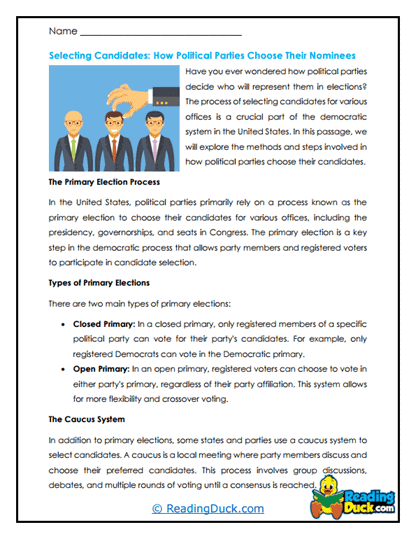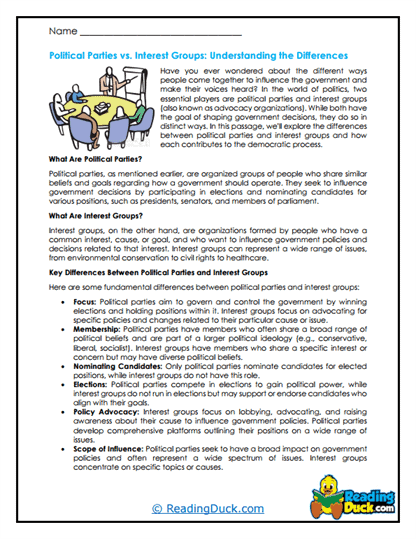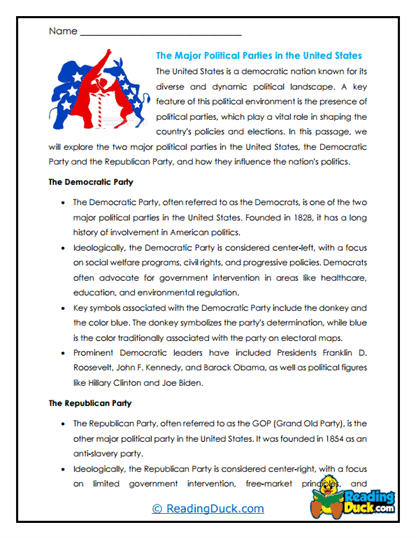Political Parties Worksheets
About Our Political Parties Worksheets
Our Political Parties worksheets are designed to give students a deep understanding of the history, development, and impact of political parties in the United States. These worksheets explore how political parties have shaped American politics and government, helping students connect historical events to current political dynamics.
Each topic in this collection contains several worksheet sets, structured to enhance students' comprehension and engagement through different types of questions:
- Multiple Choice Questions: Assess students' grasp of key facts, historical events, and the roles of political parties.
- Short Answer Questions: Encourage students to explain concepts and ideas in their own words, reinforcing their understanding of the material.
- Open-Ended Questions: Provide students with the opportunity to reflect on their personal views, make connections to current events, and critically analyze the topic.
An answer key is provided for every question sheet, supporting teachers and parents in assessing students' progress. All of the worksheets are available as PDF files, making them easily accessible for electronic viewing, downloading, and printing.
Understanding the Role of Political Parties in the U.S.
The Birth of Political Parties: When discussing the origin of political parties in the United States, it’s essential to start with the early debates and divisions among the nation's founders. Here's how you might present this to students:
- Founding Fathers’ Divisions:
- The first political parties in the U.S. emerged from the deep ideological divides between key figures like Alexander Hamilton and Thomas Jefferson. Hamilton’s Federalist Party advocated for a strong central government and a robust financial system, while Jefferson’s Democratic-Republican Party championed states’ rights and agricultural interests.
- Students should understand how these early parties set the stage for the two-party system that dominates American politics today.
- Evolution of the Two-Party System:
- Over time, the U.S. political landscape evolved into a stable two-party system, with the Federalists giving way to the Whigs, and eventually the modern-day Republican and Democratic parties. Each shift reflected changes in the nation’s priorities, such as industrialization, civil rights, and economic policy.
- Discuss with students how third parties and splinter groups have influenced major parties, and how the two-party system shapes political discourse in the U.S.
- Political Platforms and Policies:
- Political parties have always been defined by their platforms—the set of policies and principles they advocate for. These platforms have evolved over time to address the changing needs and concerns of the American people.
- Help students explore the differences between the platforms of major parties and how these platforms influence elections, policy-making, and governance.
- Political Parties and Elections:
- Political parties play a crucial role in the electoral process, from nominating candidates to mobilizing voters. The primary and general election processes are heavily influenced by party politics, with each party working to secure the best possible outcome for their candidates.
- Students should learn about the mechanisms of party conventions, primaries, and the general election, as well as how parties influence voter turnout and campaign strategies.
- Impact on Governance:
- Once in office, elected officials often govern according to their party’s platform and the interests of their party’s base. This dynamic affects how laws are made, how policies are implemented, and how the government functions overall.
- Discuss with students the concept of partisanship, gridlock, and how political parties can both facilitate and hinder effective governance.
- Political Parties and Public Opinion:
- Political parties are also a reflection of public opinion. They must adapt to the changing views and values of the electorate to remain relevant and successful.
- Encourage students to think about how public opinion shapes party platforms and how parties, in turn, shape public opinion through media, campaigns, and grassroots movements.
The Significance of Political Parties in U.S. History
1. Shaping the Nation’s Direction:
- Policy Development: Political parties have been instrumental in shaping U.S. domestic and foreign policies. From the Federalists’ push for a strong national bank to the New Deal policies of the Democrats, parties have directed the course of American history.
- National Unity and Division: Political parties have also been a source of both unity and division in the U.S. While they help organize political thought and action, they have also been at the center of some of the nation’s most divisive issues, such as slavery, civil rights, and economic inequality.
2. Representation of Diverse Interests:
- Voices of Different Constituencies: Political parties provide a platform for various groups and interests to be represented in government. Whether it’s labor unions, business interests, or social movements, parties are a way for diverse voices to be heard in the political process.
- Evolution of Party Platforms: Over time, party platforms have evolved to reflect the changing priorities of their constituents. This adaptability is crucial for the survival and success of political parties in a dynamic society.
3. Influence on Electoral Outcomes:
- Election Strategies: Political parties are central to the electoral process in the U.S. They develop strategies, fundraise, and campaign to get their candidates elected. Their influence is seen in how they shape the narrative of elections and how they respond to emerging political trends.
- Voter Mobilization: Parties also play a key role in mobilizing voters. They work to increase voter turnout among their supporters, which can be decisive in close elections.
4. Governance and Policy Implementation:
- Legislative Process: Once elected, party members often work together to pass legislation that aligns with their party’s platform. This cooperation can lead to significant policy achievements, but it can also result in gridlock when parties are deeply divided.
- Executive Influence: The President’s relationship with their party can significantly impact their ability to govern effectively. Presidents who have strong party support are often able to push through their agendas more successfully than those who face opposition within their own party.
From Social Studies Classes and Beyond
Using These Worksheets Effectively:
- Social Studies Classes:
- Historical Case Studies: Use the worksheets to explore specific historical examples of how political parties influenced key events, such as the passage of the Civil Rights Act or the New Deal. This can help students understand the practical impact of party politics.
- Debates on Party Platforms: Organize classroom debates where students defend or critique the platforms of different political parties. The worksheets provide a solid foundation of knowledge for these discussions.
- Civics and Government Classes:
- Understanding the Electoral Process: Use the worksheets to guide students through the electoral process, from primaries to the general election. This can include role-playing activities where students simulate a political campaign or election.
- Analyzing Partisanship: Discuss the role of partisanship in modern U.S. politics, using the worksheets to examine how it affects governance and policy-making.
- History Classes:
- Evolution of Political Parties: Trace the evolution of political parties in the U.S. from the Federalists and Democratic-Republicans to the current two-party system. The worksheets can help students connect historical developments with the present-day political landscape.
- Third Parties and Movements: Explore the impact of third parties and political movements on U.S. history, using the worksheets to highlight key figures and events.
- Language Arts Integration:
- Political Speeches and Rhetoric: Use the worksheets to analyze famous political speeches, examining how language and rhetoric are used to persuade and mobilize voters. Students can then write their own speeches based on a historical or contemporary issue.
- Critical Essays: Encourage students to write essays that analyze the role of political parties in a specific historical event or period. The worksheets provide the background information and structure needed for in-depth analysis.
- Homeschooling and Remote Learning:
- Flexible Learning Paths: The worksheets are ideal for homeschooling or remote learning environments, allowing students to explore the topic of political parties at their own pace.
- Multimedia Learning: Pair the worksheets with documentaries, podcasts, or online resources to create a multimedia learning experience. This approach can help students engage with the material in diverse ways and deepen their understanding.
By integrating these Political Parties worksheets into your curriculum, you can provide students with a thorough understanding of the role political parties have played in shaping U.S. history and politics. These worksheets offer a structured yet flexible approach to learning, encouraging critical thinking, historical analysis, and a deeper connection to the events and ideologies that have influenced the nation’s political landscape.









